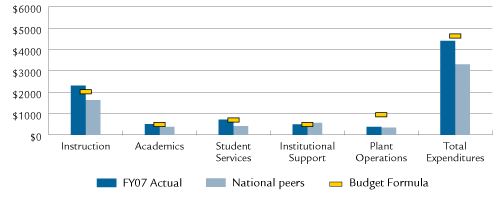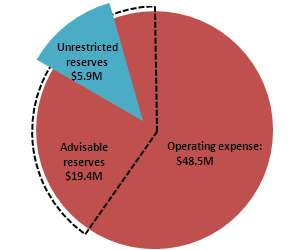Quinsigamond Community College
Quinsigamond Community College (QCC) serves the diverse educational needs of central Massachusetts by providing affordable, accessible and high-quality programming leading to transfer, career and lifelong learning. Feeling strongly that well-educated and responsible citizens are important assets to the community, Quinsigamond offers opportunities for personal, workforce and intellectual growth, giving students the right ingredients to prepare for a successful future in chosen careers.
Program of Distinction
Collaborations
Access Indicators
Affordability Indicators
Student Success and Academic Quality Indicators
Fiscal Effectiveness and Efficiency Indicators
Program of Distinction
Paramedics often function as the most extensively trained primary care providers in the pre-hospital setting. They are responsible for all aspects of care provided to the sick and injured and provide both basic and advanced life support, including comprehensive patient assessment, invasive airway management, cardiac monitoring and administration of medications. Quinsigamond Community College (QCC) recently developed and approved the cutting-edge Advanced Placement Paramedic to Associate Degree in Nursing (ADN) completion program. This program is one of a few of its type offered locally and nationally.
The QCC Paramedic to ADN Bridge Program has been designed for students who have achieved an AS in Paramedic Technology. Once applicants have met admission criteria for the ADN program, they are given Advanced Placement into a second-level nursing course. In order to achieve this, students must take a one-credit course specifically designed for the Paramedic Bridge student, as well as a one-credit transition course where they transition with students who are LPNs. Once accepted into the Advanced Placement Paramedic to ADN Program, students can complete the program in one calendar year.
Collaborations
- QCC's Children's School collaborated with the Worcester Community Action Council and the Worcester public schools through the "YouthWorks Pre-employment Training" initiative to provide Worcester high school graduates with the opportunity for summer employment as assistant teachers at the QCC Children's School. Worcester high school graduates who participated this past summer are now enrolled in QCC's Early Childhood Education Program.
- For the last two years, QCC and Worcester Technical High School have collaborated to plan and implement several targeted outreach events for careers in the following fields: business, hospitality, information technology, engineering and manufacturing. Respective QCC faculty members, deans and Admissions staff presented to students, parents, guardians, teachers and guidance counselors on labor market trends and hiring within the various professions, as well as the importance of obtaining an associate or a more advanced degree in building one's career.
- For the past two years, approximately 20 QCC students have been certified to take part in the Internal Revenue Service's Volunteer Income Tax Assistance (VITA) program which provides free tax help to low-to-moderate income people who cannot prepare their own tax returns. In 2008, QCC's VITA partner site was the Main South Community Development Corporation (CDC). This VITA site posted the best results ever from a first year site in the five-year history of the Worcester Earned Income Tax Coalition: eleven QCC students returned an average of $17,515 per volunteer. In total, QCC students helped return $192,660 to area families.
- QCC received a $750,000 grant award from the National Science Foundation to design and launch a public communications campaign focused on regional career opportunities in manufacturing. This 2007-2010 grant initiative is aimed at producing more engineering technicians to meet regional advanced manufacturing workforce demand, and targets the career decision-making of adult job seekers and K-12 students, particularly under-represented minorities and women. QCC's Mass-TEC partners include the Worcester public schools, several area colleges and community based organizations, Intel Corporation, and the Commonwealth Corporation.
- QCC's developmental mathematics department has been working towards a comprehensive program since fall 2003 through a Title III grant. Developmental math coaches provide guidance, direction and support to both full-time and adjunct faculty. The coaches have made great strides towards developing a comprehensive developmental math program with the sequencing of three developmental math courses from Basic Math to Intermediate Algebra. All students must participate in cumulative departmental final exams to receive a 73% or better grade to satisfy the pre-requisite to the next level of mathematical studies. This, coupled with a state-of-art Math Center, has created a successful developmental math curriculum at QCC.
- QCC's Training and Education Center (TEC) partnered with Worcester's Clark University to create an advanced English as a Second Language Program focusing on students enrolled in Clark's Masters of Business Administration Degree Program. As a result of this collaboration, a customized curriculum utilizing the pedagogy of case studies was developed to provide students with the opportunity to apply English to particular business issues while simultaneously helping them hone and perfect their English language skills.
Section I: Access to Public Higher Education in Massachusetts
Access Indicators
Fall 2007 Enrollment
| Headcount |
6,653 |
| FTE |
4,116 |
Fall Enrollment
Over the last three years, fall headcount enrollment has increased 11.5%.
Over the last three years, fall full-time equivalent (FTE) enrollment has increased 13.6%.
Annual 2007–2008 Enrollment
| Headcount |
9,455 |
| FTE |
4,446 |
Annual Enrollment
Over the last three years, annual headcount enrollment has increased 12.8%.
Over the last three years, annual FTE enrollment has increased 13.6%.
Looking Back: Fall and Annual Headcount Enrollment

Fall 2007 Minority Enrollment
26.2%
Minority Enrollment
Greater than the minority representation of the institution's primary draw cities and towns (14.1%) and the Central Region's minority representation of 11.8%.
Section II: Affordability of Massachusetts Community Colleges
Affordability Indicator
2007–2008 Tuition and Fees as a Percent of Median Family Income
4.9%
% of Median Family Income
Comparable to the Northeast regional average of 4.9%.
Looking Back: Tuition and Fees as a Percent of Median Family Income
|
FY2004 |
FY2005 |
FY2006 |
FY2007 |
FY2008 |
| Quinsigamond Community College Tuition and Fees |
$3,600 |
$3,600 |
$3,600 |
$3,750 |
$3,870 |
| State Median Family Income |
$67,527 |
$68,701 |
$71,655 |
$74,463 |
$78,497 |
| "X" as a Percent of State Median Family Income |
| X = Quinsigamond Community College Tuition and Fees |
5.3% |
5.2% |
5.0% |
5.0% |
4.9% |
| X = Massachusetts Community Colleges' Average Tuition and Fees |
4.8% |
4.9% |
4.9% |
4.7% |
4.7% |
| X = Northeast Average Tuition and Fees |
|
4.8% |
4.8% |
4.9% |
4.9% |
Section III: Student Success and Academic Quality
Success and Quality Indicators
Fall 2006 Cohort First-Year Persistence Rate
| Retained at original institution |
54.6% |
| Retained at any institution |
62.3% |
Fall Cohort First-Year Persistence
Persistence at original institution has remained stable over the last three years and is comparable to the segmental average of 56.5%.
Looking Back: Fall-to-Fall First-Year Persistence Rate

Fall 2003 Cohort Four-Year Overall Success Rate
70.8%
Fall 2003 Cohort Four-Year Individual Success Rates
| Earned Degree/Certificate |
24.8% |
| Transferred |
19% |
| Earned 30 Credits |
25.4% |
| Still Enrolled |
1.7% |
| Note: Each subsequent category excludes any student included in previous category(ies) |
Fall Cohort Four-Year Overall Success Rate
This new indicator measures students who have earned a degree/certificate, transferred to another institution, earned 30 or more credits, or are still enrolled after four years. Future reports will include these outcomes over four, five, and six years for this and successive cohorts. Please see the Technical Guide for further details regarding this indicator.
2007–2008 Fall-to-Spring Retention Rate
94.9%
Fall-to-Spring Retention Rate
Fall-to-spring retention has increased 5.5 percentage points over the last three years.
FY2008 Credit Course Completion Rate
74.8%
Course Completion
Comparable to the Board of Higher Education's target rate of 75%.
Total Degrees Conferred in FY2008
775
Degrees Conferred
Average degrees conferred per year over the last three years: 745
Looking Back: Degrees Conferred

2007 Pass Rate on the National Nursing Licensure Examination
78.5%
Nursing Exam Pass Rate
Below the Board of Higher Education's target pass rate of 85%.
FY2008 Annual Enrollment in Workforce Development Courses
5,731
Workforce Development
Average annual enrollment in workforce development courses per year over the last three years: 5,127
Section IV: Effective and Efficient Use of Resources
Effectiveness and Efficiency Indicators
Effective Projects and Initiatives
- The College refinanced MHEFA bond, securing improved liquidity and lower interest rates, generating an expected annual savings of $15,000.
- The College entered into a merchant service arrangement with credit card vendor, expected to result in a savings of approximately $20,000 on credit card transactions costs.
- By coordinating funding from a private grant (80%) and investing college operating funds (20%), the College completed a significant rehabilitation of a major science laboratory.
- Significantly upgraded access to the college via the Internet, including enhancements to the payroll system, credit card processing in the Advancement Office, online application and payment systems for enrollments at the Athletic and Child Care Centers, and online draw-down system for grants from the Department of Education.
Resource Allocation
Expenditures per Student—Actual, National Peers, and Budget Formula

Note: This graphic was revised on May 6, 2009. The previously posted graphic displayed the data inaccurately.
FY2008 Primary Reserve Ratio
| Unrestricted Reserves (UR) |
$5,951,278 |
| Total Operating Expenses (TOE) |
$48,570,545 |
| Primary Reserve Ratio (UR/TOE) |
12.3% |
Primary Reserve Ratio

Compliance
No materials weaknesses based on annual external independent audit:

